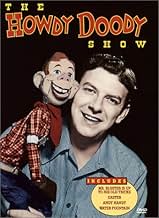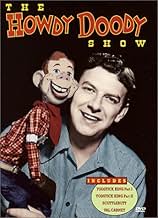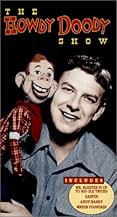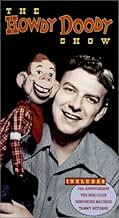Adicionar um enredo no seu idiomaThe first nationally televised American children's TV program and a prototype for what followed. Buffalo Bob Smith hosts while the puppet, Howdy Doody, stars.The first nationally televised American children's TV program and a prototype for what followed. Buffalo Bob Smith hosts while the puppet, Howdy Doody, stars.The first nationally televised American children's TV program and a prototype for what followed. Buffalo Bob Smith hosts while the puppet, Howdy Doody, stars.
- Indicado para 2 Primetime Emmys
- 1 vitória e 2 indicações no total
Explorar episódios
Avaliações em destaque
I watched this show everyday when I was a child in the '50s. I was even on the show once as a member of the 'Peanut Gallery'. Kids need more of this type of programming today and less of the pseudo violence and political programming that is labeled as 'kids TV' today. This stirs imagination, which in turn stirs creativity in children. The actors were wholesome people. Bob Keeshan who played 'Clarabell the Clown' for several years, later became successful as 'Captain Kangaroo'. Bob Smith who was also known as 'Buffalo Bob' did a lot of touring and public appearances. He was kind to children, I remember the day that I got to be in the 'Peanut Gallery', I was 8, Buffalo Bob was kind and not at all flustered by a bunch of young children. He seemed to really like kids.
Catchy jingle at the beginning of the end of each episode is sure to have you bounding around the house singing. I like the interaction with the kids in the audience. There's some coaching but often kids give some very creative and funny responses. The old timey movie in the show is some goofy fun thrown into the mix. Puzzles and games provide interactive fun.
There was a bit of showboating the network which seemed awkward, but better than modern TV ads. The theme for the show tends to get a little lost in all the hoopla, but there is an attempt to tie it in and bring the theme back to the point. We can see how this definitely a template for future children's television programming.
There was a bit of showboating the network which seemed awkward, but better than modern TV ads. The theme for the show tends to get a little lost in all the hoopla, but there is an attempt to tie it in and bring the theme back to the point. We can see how this definitely a template for future children's television programming.
Howdy Doody" was the first television show I ever remember watching as a very young kid. I hadn't seen it in about 55 years so, at first, it was kind of shocking to view a few episodes just the other day. A new DVD by Mill Creek Entertainment came out last last year (2008) and contains a number of episodes from 1949-1952 and all of them with pretty good transfers.
The show is not something I could enjoy now as a 60-plus-year-old man, but it was interesting to see the principal characters again. I viewed three of the episodes and, frankly, that was enough. It was fascinating to look back, though. I can't believe how the plugs they did for their sponsors, like Halo Shampoo or Three Muskateeres candy bar, were worked into an audience-participation thing. It's so different from what we've known the last 40 years. Instead of cutting away to a commercial, they plugged the products as part of the show.
Speaking of participation, I had also forgotten exactly how young the audience - the famous "Peanut Gallery" - was, the kids all looking about five years old. This was definitely a show for very young kids. The only part that I still enjoyed was the old silent film comedies. In each half-hour Howdy Doody episode, they showed a silent-film comedy with Buffalo Bob explaining some of the things going on. The old slapstick films are still funny, of course.
It also looked like the show did a lot to promote the American Indian. Yeah, they might have been white men dressed up as Native Americans, but there were a number of characters in this show and they were not portrayed negatively. They were live humans and puppets.
The other "live" people included a star of the show: "Clarabell" The Clown. Clarabell was like Harpo Marx, a silent pantomime figure who honked instead of spoke and made a lot of faces, many of them sad. He was first played by Bob Keeshan, who went on to big fame as "Captain Kangaroo."
The only thing that baffled me was seeing "Princess Summerfallwinterspring," whom I always remembered as a beautiful young women. Here, she's a puppet. I did some research, though, and found out she started out as a puppet on this show and then became a real-life human, played by Judy Tyler. By the way, Tyler played opposite Elvis Presley in the 1957 film, "Jailhouse Rock." Tragically, the woman and her husband were killed later that year in a car crash. Elvis said he could never watch that movie again, because seeing Judy would be too much to bear.
All in all, I still can't have anything but the fondest thoughts for this show, which first brought me the joys of television entertainment. Buffalo Bob Smith will always be a folk-hero of sorts to me, and millions of other Baby Boomers.
The show is not something I could enjoy now as a 60-plus-year-old man, but it was interesting to see the principal characters again. I viewed three of the episodes and, frankly, that was enough. It was fascinating to look back, though. I can't believe how the plugs they did for their sponsors, like Halo Shampoo or Three Muskateeres candy bar, were worked into an audience-participation thing. It's so different from what we've known the last 40 years. Instead of cutting away to a commercial, they plugged the products as part of the show.
Speaking of participation, I had also forgotten exactly how young the audience - the famous "Peanut Gallery" - was, the kids all looking about five years old. This was definitely a show for very young kids. The only part that I still enjoyed was the old silent film comedies. In each half-hour Howdy Doody episode, they showed a silent-film comedy with Buffalo Bob explaining some of the things going on. The old slapstick films are still funny, of course.
It also looked like the show did a lot to promote the American Indian. Yeah, they might have been white men dressed up as Native Americans, but there were a number of characters in this show and they were not portrayed negatively. They were live humans and puppets.
The other "live" people included a star of the show: "Clarabell" The Clown. Clarabell was like Harpo Marx, a silent pantomime figure who honked instead of spoke and made a lot of faces, many of them sad. He was first played by Bob Keeshan, who went on to big fame as "Captain Kangaroo."
The only thing that baffled me was seeing "Princess Summerfallwinterspring," whom I always remembered as a beautiful young women. Here, she's a puppet. I did some research, though, and found out she started out as a puppet on this show and then became a real-life human, played by Judy Tyler. By the way, Tyler played opposite Elvis Presley in the 1957 film, "Jailhouse Rock." Tragically, the woman and her husband were killed later that year in a car crash. Elvis said he could never watch that movie again, because seeing Judy would be too much to bear.
All in all, I still can't have anything but the fondest thoughts for this show, which first brought me the joys of television entertainment. Buffalo Bob Smith will always be a folk-hero of sorts to me, and millions of other Baby Boomers.
This show is a good example of how children have changed since the halcyon haze of the 1950s. Back then, this show and its characters were beloved to seemingly most children, but now, children would be frightened by evil-looking puppets and clowns.
It's hard to believe that a children's show, much less one like this, could endure for nearly 2500 episodes. Oh well. I suppose children's television hasn't changed that much since the 1950s, after all -- Mr. Rogers is still around, as he was in the 50s, and modern children's shows have retained their simple, mindless guile, while at the same time keeping kids glued to their TVs for a few hours each day.
It's hard to believe that a children's show, much less one like this, could endure for nearly 2500 episodes. Oh well. I suppose children's television hasn't changed that much since the 1950s, after all -- Mr. Rogers is still around, as he was in the 50s, and modern children's shows have retained their simple, mindless guile, while at the same time keeping kids glued to their TVs for a few hours each day.
I first saw "Puppet Playhouse" at the age of 5 on a neighbor's 5-inch GE TV (with a magnifying glass over the screen so that we could all see it). At that time, I lived near Buffalo, NY. Buffalo Bob's constant references to places around Buffalo brought the context a little closer. Then there were the old time movies, featuring Mickey McGuire and the Tons of Fun.
I also watched The Camel News Caravan, I Remember Mama, Milton Berle and all sorts of programs which stimulated my curiosity and imagination. And all this without the benefit of special effects that are now available. And, more importantly, a lot more imagination at play, than one would find in later years.
Years later when I'm watching my children watch cartoon characters flying around with devastating rays coming from their bare hands, I quickly devise ways to get the kids away from this stuff. My opinion is that (like another commenter) is that my kids missed some pretty neat stuff.
I also watched The Camel News Caravan, I Remember Mama, Milton Berle and all sorts of programs which stimulated my curiosity and imagination. And all this without the benefit of special effects that are now available. And, more importantly, a lot more imagination at play, than one would find in later years.
Years later when I'm watching my children watch cartoon characters flying around with devastating rays coming from their bare hands, I quickly devise ways to get the kids away from this stuff. My opinion is that (like another commenter) is that my kids missed some pretty neat stuff.
Você sabia?
- CuriosidadesThis was the first nationally televised American children's television show.
- Citações
[final episode. Clarabell speaks for the only time in the show's history]
Clarabell the Clown: Goodbye, kids.
- ConexõesFeatured in The Movie Orgy (1968)
Principais escolhas
Faça login para avaliar e ver a lista de recomendações personalizadas
- How many seasons does The Howdy Doody Show have?Fornecido pela Alexa
Detalhes
- Data de lançamento
- País de origem
- Idioma
- Também conhecido como
- The Howdy Doody Show
- Locações de filme
- Empresa de produção
- Consulte mais créditos da empresa na IMDbPro
- Tempo de duração
- 30 min
- Mixagem de som
- Proporção
- 1.33 : 1
Contribua para esta página
Sugerir uma alteração ou adicionar conteúdo ausente

















